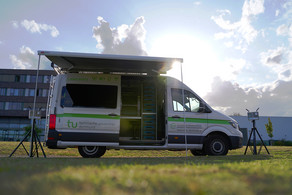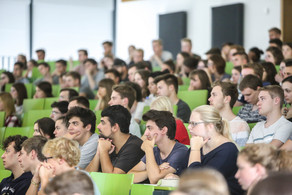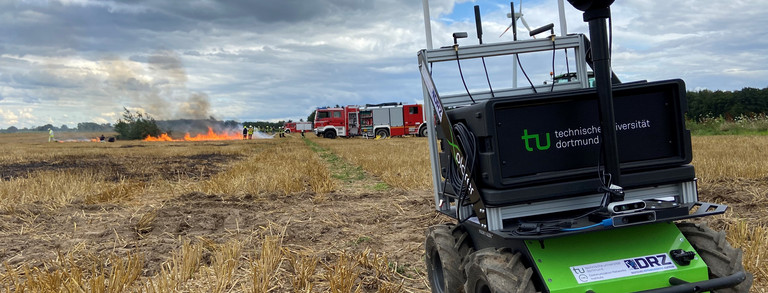DRZ
In their daily work, task forces face a variety of challenges. Despite training, tactical concepts and protective equipment, thousands of emergency personnel are injured or killed worldwide every year. With the advancing technical development, it is foreseeable that mobile robot systems will take over tasks in order to make the operation more efficient and above all safer. The requirements on the supporting rescue robot systems are complex and varied.
Project duration: 01.10.2018 - 30.09.2022 (Phase 1: A-DRZ); 01.10.2022 - 30.09.2026 (Phase 2: DRZ)

The German Rescue Robotic Centre (DRZ) is intended to promote the use of robot systems in civil terrestrial emergency response in hostile environments. Here, the four guiding scenarios of fire, collapse & burial, detection of hazardous substances and flooding as well as the resulting challenges for rescue robotics form the basis. Among other activities, a so-called Living Lab will be set up for this purpose, i.e. a laboratory with an attached test site, in which scientists, companies and users can jointly research the best possible solutions for supporting rescue robots and test them in realistic environments.
The implementation of the DRZ will create a national competence centre with international appeal. For the first time in Germany, emergency forces, researchers and industry will work on the realization of autonomous rescue robots and the establishment of a national and international robotics task force. In addition, test and inspection criteria are developed in order to ensure later standardization and certification of different robot systems. The Communication Networks Institute (CNI) will be in charge of the work on robust wireless networking of robotic systems even under the difficult conditions of a rescue operation.
The project is funded by the German Federal Ministry of Education and Research under the grant agreement number 13N16476.
News
Journal article on joint research in German Rescue Robotics Centre published
The article presents three selected missions of the German Rescue Robotics Centre, in which networked ground and aerial robots were used.
Successful 6GEM Demonstration in the Test Field of Rescue Robotics
The 6GEM team of the rescue robotics test field, led by TU Dortmund-CNI, has successfully achieved all milestone project goals in the second year.
CNI introduces new communication-related challenge to Robocup Rescue Word Championship
Remote-controlled rescue robots were challenged with CNI's vSTING to prove their ability to operate in the face of impaired communications.
6GEM@INTERSCHUTZ 2022: Demonstrating the potential of the future Rescue Robotics Metaverse
CNI presents the 6GEM vision of future immersive control of robots in rescue missions by first responders on the DRZ booth at INTERSCHUTZ 2022.
BMBF 6G research hub "6GEM" visits DRZ Living Lab for evaluation experiments
Which added value can future 6G mobile communications systems provide for highly relevant use cases in society and industry? This is one of the…
5G.NRWeek Rocket Session: interactive live rescue robotics demo at high-profile 5G event
CNI has interactively illustrated requirements and opportunities of 5G in rescue robotics in close cooperation with the Fire Department Dortmund and…
Publications
COMPASS: Communication-aware Trajectory Planning for UAV-based Rescue Missions via Non-Terrestrial Networks
T. Gebauer, F. Weißberg, C. Wietfeld
In 2024 IEEE 99th Vehicular Technology Conference (VTC-Spring), June 2024.
Aerial-DRaGon: Machine Learning-based Channel Modeling for Airspace Communication Networks
M. Geis, T. Gebauer, H. Tuna, C. Wietfeld
In IEEE International Conference on Communications (ICC) Workshops, June 2024.
Lessons from Robot-assisted Disaster Response Deployments by the German Rescue Robotics Center Task Force
H. Surmann et al.
In Wiley Journal of Field Robotics, Dec. 2023
SEAMLESS: Radio Metric Aware Multi-Link Transmission for Resilient Rescue Robotics
T. Gebauer, M. Patchou, C. Wietfeld
In IEEE International Conference on Safety, Security, and Rescue Robotics (SSRR), Nov. 2023.
Distributed Realtime Wireless Network Emulation for Multi-Robot and Multi-Link Setup Evaluation
M. Patchou, T. Gebauer, C. Krieger, S. Böcker, C. Wietfeld
In IEEE Int. Conference on Safety, Security, and Rescue Robotics (SSRR), Nov. 2023.
Realtime Wireless Network Emulation for Evaluation of Teleoperated Mobile Robots
M. Patchou, et al.
In 2022 IEEE International Symposium on Safety, Security, and Rescue Robotic (SSRR), November 2022, Sevilla, Spain.
QoE Evaluation of Real-Time Remote Operation with Network Constraints in a System-of-Systems
C. Schüler, T. Gebauer, M. Patchou, C. Wietfeld
In 2022 Annual IEEE International Systems Conference (SysCon), Virtual Event.
Experimental Evaluation of IEEE 802.15.4z UWB Ranging Performance under Interference
J. Tiemann, J. Friedrich, C. Wietfeld
In Sensors, vol. 22, no. 4, 2022.
Modeling and simulation of reconfigurable intelligent surfaces for hybrid aerial and ground-based vehicular communications
K. Heimann, B. Sliwa, M. Patchou, C. Wietfeld
In Proceedings of the 24th International ACM Conference MSWiM 2021





